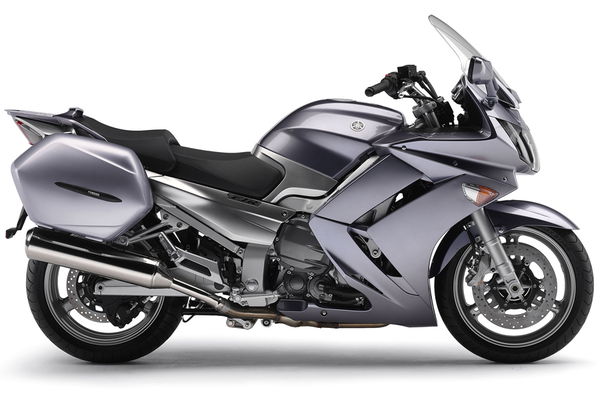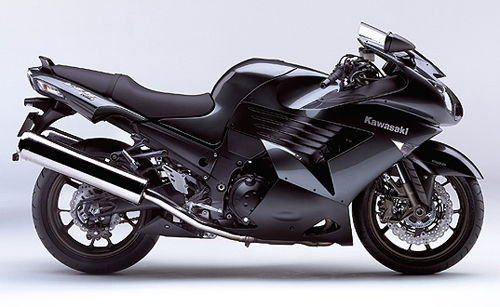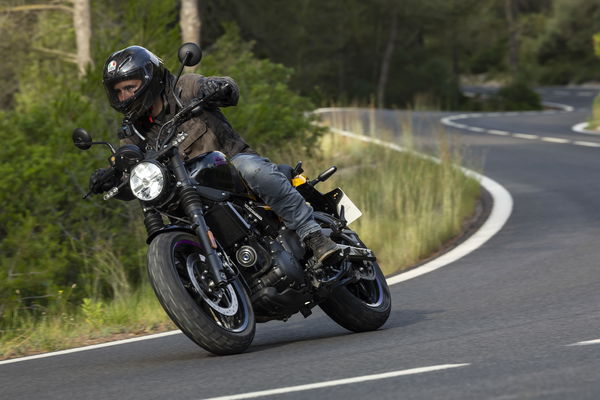FJR1300 A AS (2003 - 2012) review
Personally I’m a fan of new technology, as long as it works well and enhances my life. But new technology that hinders me really pisses me off. Take digital cameras, which seem to have a 10-second delay between pressing the button and the picture being taken as an example. And don’t even get me started on the whole fuel injection v carbs debate.
And so it was I approached Yamaha’s new FJR1300AS with its electronic gear change and auto clutch with an open mind.

Personally I’m a fan of new technology, as long as it works well and enhances my life. But new technology that hinders me really pisses me off. Take digital cameras, which seem to have a 10-second delay between pressing the button and the picture being taken as an example. And don’t even get me started on the whole fuel injection v carbs debate.
And so it was I approached Yamaha’s new FJR1300AS with its electronic gear change and auto clutch with an open mind.
But before we deal with that we should consider the revised FJRs as a whole. Both the FJR1300A and AS are absolutely (nearly) identical and come with Yamaha’s combined brakes and ABS as standard, not to mention colour coded panniers, but for £1000 more the AS has the YCC-S shifiting system and heated grips.
That aside, what’s changed for 2006? The FJR gets a heap more adjustability. The bars have three different positions, the seat has two heights, the middle fairing can be moved out slightly for more weather protection and the electrically operated screen is taller and moves through a wider range of heights.
In addition the pillion pegs have been moved forward for greater passenger comfort and the instruments redesigned to include a gear indicator on both models. Finally the forks are new for a smoother action, the swingarm longer for greater stability, the final drive ratio has been made higher to reduce vibrations during motorway riding and ABS brakes are standard.
All these modification are aimed at making the FJR an easier bike to tour on, which it certainly is – on fast motorways the FJR is rock solid and the fairing excellent.
Although the engine modifications are slight there never was much wrong with the old FJR’s motor. The inline four has mountains of torque which means it will happily pull in top gear from as low as 2500rpm. It’s not the most inspiring motor as the power is delivered in a totally linear fashion but for a tourer this is perfect. Rolling on and off the throttle there is a certain jerkiness as the fuel-injection kicks in, but this could be a combination of slightly poor injection and the inherent delay in delivering power to the rear that a shaft drive always has. What is more annoying is the ABS system.
Yamaha’s ABS seems far too keen to cut in, even when it doesn’t feel like there’s any chance of the front locking. Braking even slightly hard soon gets the lever pulsing as the ABS cuts in. Unlike some systems the ABS isn’t intrusive and doesn’t give the feeling the bike isn’t going to stop, but the pulsing is annoying. To be completely fair some of this may be due to my riding style. I rarely use the back brake but on the FJR, while the front brake lever only operates the front calipers, when a certain amount of power is put through the rear it operates one set of pistons up front a well as all at the back. For fast stops I thoroughly recommend the use of both brakes.
The FJR is aimed at the slightly sportier tourer and the chassis reflects this. Despite being a big old lump at a claimed 264kg dry (270kg for the AS) the FJR hides its weight well. Riding it hard soon shows up a lack of ground clearance, but I’m guessing the average rider – who, according to Yamaha, is 45 years old – won’t really be pushing that hard. Although with luggage and a pillion on board I would prepare for a few scrapes on the hero blobs.
Now, onto the FJR1300AS and its YCC-S, or Yamaha’s Chip Controlled Shift. There have already been a few misconceptions about this system, so let’s clear a few things up. Firstly, it isn’t an automatic gearbox. Instead, it’s an automatic clutch with an electronically operated gearbox. What this means is that the rider has to make a physical input in order to change gear. True, this input is only a flick of a handlebar mounted switch, or prod of the traditional-looking foot gear lever, but it still requires rider interaction to change gear. Secondly, it isn’t that revolutionary or even complex
So what’s it like? Initially it’s a very strange feeling. At a standstill you have to hold on the front brake before the engine will start, much like a scooter, and once the engine is running the FJR will simply sit there, even with first selected. So you are sat on a running bike, in first gear, and it isn’t moving. Odd. Now comes pulling away. Opening the throttle a little way picks the revs up, and at about 2000rpm you can feel the clutch start to bite a bit then, with a lurch, you’re off. First criticism: it isn’t that smooth pulling away with the auto clutch.
Next time you take your bike for a ride see how much you slip the clutch while pulling away – quite a lot I’d guess. Well, the YCC-S doesn’t really have this slipping ability, so pulling away is much more of a positive dive rather than a smooth progression. The kick can be calmed slightly with some use of the brake, but it’s nowhere near as smooth as a manual clutch pull-away. Pulling onto roundabouts is a case of seeing a gap, opening the throttle, lurching forward and trusting the bike will go. Which it does, although I doubt a pillion will appreciate the technique. But there is one advantage – according to Yamaha it’s impossible to stall a bike with the YCC-S system.
On the move the system starts to come into its own. Prod the lever for an upchange and the engine note does a kind of ‘urrph’ noise, followed by a slight clunk, and you’re a gear higher, according to the digital gear indicator. No fuss, and the ‘urrph’ noise can be eliminated by slightly rolling off the throttle when you push the gear change button. Because the throttle is totally independent of the auto gear mechanism the engine will rev slightly on a disengaged clutch if you keep the throttle open while it is trying to change gear.
I rode the auto FJR1300 for half a day on twisty Spanish roads and, although it was a bit of a pain through town and when pulling away (due to the lurch), once on the move it really is a good system. To be fair it’s little more than a lazy man’s gear change, but on roads where you are continually darting between second and third it comes into its own. Just one word of warning: it really is dreadful for U-turns. Look for the closest roundabout instead.
Overall the FJR1300 is a very competent sports tourer that is slightly sportier than Honda’s Pan European and comes with more adjustability and a stronger engine. The updates to both models are well thought out reactions to owner’s complaints that definitely improve the model. The ABS is irritating but can be overcome with a different riding style, and the throttle snatch isn’t that bad. As for the YCC-S… I’d find it hard to justify the £1000 difference in price. It’s more of a gimmick rather than life-changing development and the lack of low speed control is annoying. Ideally I’d have the YCC-S system with a manual clutch for low speed control as well, but I guess that would defeat its purpose ever so slightly.
Personally I’m a fan of new technology, as long as it works well and enhances my life. But new technology that hinders me really pisses me off. Take digital cameras, which seem to have a 10-second delay between pressing the button and the picture being taken as an example. And don’t even get me started on the whole fuel injection v carbs debate.
And so it was I approached Yamaha’s new FJR1300AS with its electronic gear change and auto clutch with an open mind.
But before we deal with that we should consider the revised FJRs as a whole. Both the FJR1300A and AS are absolutely (nearly) identical and come with Yamaha’s combined brakes and ABS as standard, not to mention colour coded panniers, but for £1000 more the AS has the YCC-S shifiting system and heated grips.
That aside, what’s changed for 2006? The FJR gets a heap more adjustability. The bars have three different positions, the seat has two heights, the middle fairing can be moved out slightly for more weather protection and the electrically operated screen is taller and moves through a wider range of heights.
In addition the pillion pegs have been moved forward for greater passenger comfort and the instruments redesigned to include a gear indicator on both models. Finally the forks are new for a smoother action, the swingarm longer for greater stability, the final drive ratio has been made higher to reduce vibrations during motorway riding and ABS brakes are standard.
All these modification are aimed at making the FJR an easier bike to tour on, which it certainly is – on fast motorways the FJR is rock solid and the fairing excellent.
Although the engine modifications are slight there never was much wrong with the old FJR’s motor. The inline four has mountains of torque which means it will happily pull in top gear from as low as 2500rpm. It’s not the most inspiring motor as the power is delivered in a totally linear fashion but for a tourer this is perfect. Rolling on and off the throttle there is a certain jerkiness as the fuel-injection kicks in, but this could be a combination of slightly poor injection and the inherent delay in delivering power to the rear that a shaft drive always has. What is more annoying is the ABS system.
Yamaha’s ABS seems far too keen to cut in, even when it doesn’t feel like there’s any chance of the front locking. Braking even slightly hard soon gets the lever pulsing as the ABS cuts in. Unlike some systems the ABS isn’t intrusive and doesn’t give the feeling the bike isn’t going to stop, but the pulsing is annoying. To be completely fair some of this may be due to my riding style. I rarely use the back brake but on the FJR, while the front brake lever only operates the front calipers, when a certain amount of power is put through the rear it operates one set of pistons up front a well as all at the back. For fast stops I thoroughly recommend the use of both brakes.
The FJR is aimed at the slightly sportier tourer and the chassis reflects this. Despite being a big old lump at a claimed 264kg dry (270kg for the AS) the FJR hides its weight well. Riding it hard soon shows up a lack of ground clearance, but I’m guessing the average rider – who, according to Yamaha, is 45 years old – won’t really be pushing that hard. Although with luggage and a pillion on board I would prepare for a few scrapes on the hero blobs.
Now, onto the FJR1300AS and its YCC-S, or Yamaha’s Chip Controlled Shift. There have already been a few misconceptions about this system, so let’s clear a few things up. Firstly, it isn’t an automatic gearbox. Instead, it’s an automatic clutch with an electronically operated gearbox. What this means is that the rider has to make a physical input in order to change gear. True, this input is only a flick of a handlebar mounted switch, or prod of the traditional-looking foot gear lever, but it still requires rider interaction to change gear. Secondly, it isn’t that revolutionary or even complex
So what’s it like? Initially it’s a very strange feeling. At a standstill you have to hold on the front brake before the engine will start, much like a scooter, and once the engine is running the FJR will simply sit there, even with first selected. So you are sat on a running bike, in first gear, and it isn’t moving. Odd. Now comes pulling away. Opening the throttle a little way picks the revs up, and at about 2000rpm you can feel the clutch start to bite a bit then, with a lurch, you’re off. First criticism: it isn’t that smooth pulling away with the auto clutch.
Next time you take your bike for a ride see how much you slip the clutch while pulling away – quite a lot I’d guess. Well, the YCC-S doesn’t really have this slipping ability, so pulling away is much more of a positive dive rather than a smooth progression. The kick can be calmed slightly with some use of the brake, but it’s nowhere near as smooth as a manual clutch pull-away. Pulling onto roundabouts is a case of seeing a gap, opening the throttle, lurching forward and trusting the bike will go. Which it does, although I doubt a pillion will appreciate the technique. But there is one advantage – according to Yamaha it’s impossible to stall a bike with the YCC-S system.
On the move the system starts to come into its own. Prod the lever for an upchange and the engine note does a kind of ‘urrph’ noise, followed by a slight clunk, and you’re a gear higher, according to the digital gear indicator. No fuss, and the ‘urrph’ noise can be eliminated by slightly rolling off the throttle when you push the gear change button. Because the throttle is totally independent of the auto gear mechanism the engine will rev slightly on a disengaged clutch if you keep the throttle open while it is trying to change gear.
I rode the auto FJR1300 for half a day on twisty Spanish roads and, although it was a bit of a pain through town and when pulling away (due to the lurch), once on the move it really is a good system. To be fair it’s little more than a lazy man’s gear change, but on roads where you are continually darting between second and third it comes into its own. Just one word of warning: it really is dreadful for U-turns. Look for the closest roundabout instead.
Overall the FJR1300 is a very competent sports tourer that is slightly sportier than Honda’s Pan European and comes with more adjustability and a stronger engine. The updates to both models are well thought out reactions to owner’s complaints that definitely improve the model. The ABS is irritating but can be overcome with a different riding style, and the throttle snatch isn’t that bad. As for the YCC-S… I’d find it hard to justify the £1000 difference in price. It’s more of a gimmick rather than life-changing development and the lack of low speed control is annoying. Ideally I’d have the YCC-S system with a manual clutch for low speed control as well, but I guess that would defeat its purpose ever so slightly.











